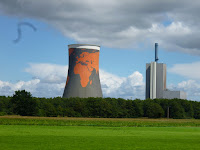Making a bike tour in Germany is not all about the bike, as there are many other considerations and observations required. Here is a list for you to ponder.
1. Someone has to drive the car. This means missing out on a riding day, which can be convenient depending on 'skin tears', bruising, tiredness or some other ailment or other that may make being on the bike more perilous than necessary. It also means navigating. Fortunately, our commodious Skoda is equipped with a satellite navigation system, otherwise known as a GPS, and the melodious voice of Emily can guide the driver in and out of narrow streets on the way into old towns, take on the best on a German Autobahn and find otherwise tucked away villages too small to make a mark on our maps. For us accustomed to driving on the left, the hardest thing is making a left-hand turn on a multi-lane road or street, and ending up on the right-hand side of the road. Other tricks include learning to turn on the indicator lights, not the windscreen wipers; and getting the hang of positioning the car in the middle of the lane rather than too far to the right which can lead to mounting gutters and knocking over rubbish bins.
 |
| Various glass recyling bins. |
3. Shooting deer is a national pastime. I'm not sure how many are shot, but spotting towers dot the countryside everywhere. Those proud of their kill may mount the skeletal heads complete with antlers attached, onto pieces of timber and screw these plaques to some wall or other. One toilet I went into had seven small skulls hanging from the walls.
4. Outside clothes lines are rare. This in a country where wind towers are as common as the deer spotting towers and thousands upon thousands of half-acres are planted out with solar panels.
5. Everything is clean. And I mean everything. We have passed many people sweeping a few leaves and some dust from the street in front of their house using a small brush and pan, and those intent on tweezering out tiny weeds growing between paving stones seem to be endlessly occupied. It wasn't until we got to Bamberg, a city of 75,000, 15,000 of whom are university students, that we noticed weeds in public and private places, and a more relaxed approach to external perfection.
6. If the red hair dye manufacturers went on strike, German women would call on Angela Merkel to declare a state of national emergency.
7. Not just a little tractor will do when you can have one or two or three, even, humongous beasts to roam around your small fields, ploughing, spreading liquid manure, raking and hay-bale collecting. It is good that farmyards are built on a grand scale to house these creatures of German industry.
8. Germany is a riot of floral splendor. Window boxes abound, yes, even on cow barns. Bridges are bedecked with hanging baskets, windowsills sport those long-flowering orchids (along with so much other 'stuff' - Kitsch indeed) pots of red geraniums decorate Biergartens and domestic gardens mix cottage favourites, including roses, with vegetables, fruit trees and grassy verges. As per point 5, everything is trimmed, dead-headed and swept presenting an immaculate picture for the passerby.
 |
| A small bridge bedecked with hanging baskets. |
9. There is nothing that Germans like better than a good old beer-fueled summer festival. Out from the wardrobes or newly purchased from the shop come the Dirndls and Lederhosen - yes, even up north there are costumes similar in nature to the Bavarian ones you might recognise - and out they go: with the dog or without; with the kids costumed or not; with grandma and grandpa most definitely. There must be huge potteries somewhere making all those ceramic steins, only a few of which end up as shards on the street on Sunday morning.
 |
| Bamberg celebrations. |
 |
| The boys in Regensburg. |
10. When entering each town there is at least one sign, sometimes more, advising the days and time when mass or communion is celebrated. This is because each town has at least one Catholic, and, more than likely, at least one other Christian-denomination church.
I have not as yet seen any mosques in the countryside. Michael said that recent asylum seeker arrivals have been housed in communities throughout the nation, the number in proportion to the overall original population. Sounds sensible. There they wait for processing, unable to work and living in a variety of accommodation including guests houses and youth hostels. Our contact with the recent arrivals has been very limited.














































